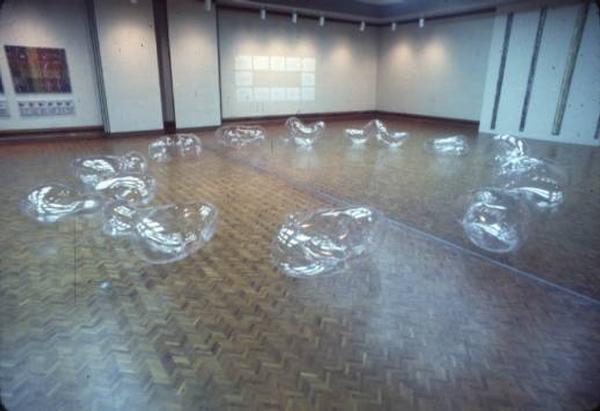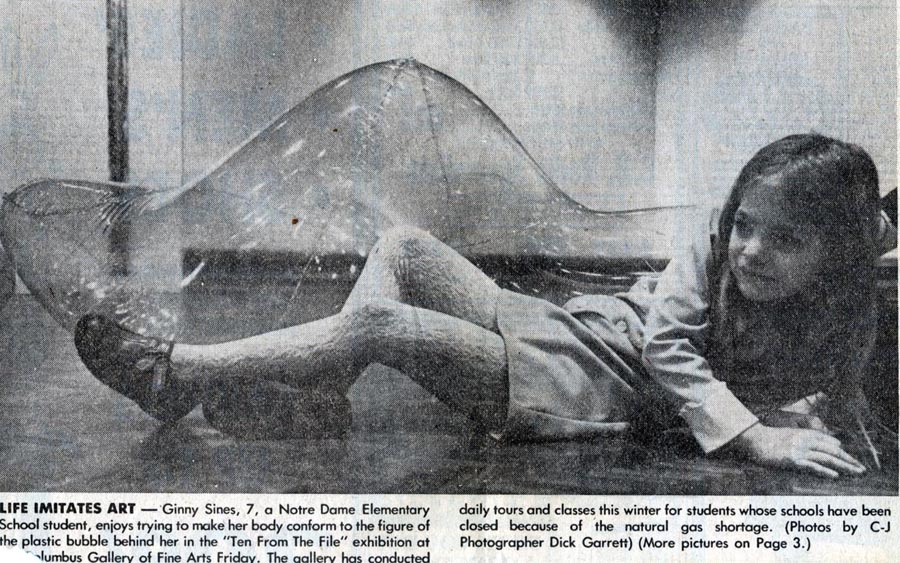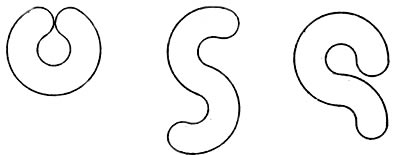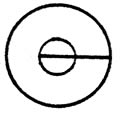|

Provenance
Con(jug)ate 3, 1977. Clear vinyl. 12 pieces, each app. 2'x3'x2'.
Con(jug)ate 3 as shown here is part of an exhibition entitled "10 from the File" curated by Lawrence Alloway for the Columbus Museum of Art in 1977. The work is a set of mirror symmetric forms with centered symmetry in a sequence of which one half is right screw followed by a second half that is a mirror sequence in left screw. The exhibition included line drawings showing the spatial twisting of the seams.
The series of Con(jug)ates and the 59 individual morphologically distinct pieces of "Anolatabulata" were closed permutative sets which eventually taught me something about symmetry, about how to construct an order and provided insight into both the startling similarities and profound differences found in biological species. At one point, my studio awash with forms, I contacted mathematician Phil Huneke who was able to relate the work to smooth tesselations of a sphere doing so in a mathematical conference paper. The collaboration was both helpful and interesting. Dr. Huneke recognized that a Zeeman's Dunce cap would be the ideal way to deploy the congruent Anolatabulata in a way that showed their relationship one to another in all directions. He did so, as with all his work, via mathematical formulations and tiny diagrams. At one point, because it became clear that our conceptual processes were very different, we found it necessary to work through all the pieces matching Dr Huneke's diagramatic notations against the individual pieces. Distracted by the physicality of the forms I struggled to find an order, just as I had struggled in life-sculpture. He grasped the structure, hardly noticed the forms.

1: Extracted from the Artist Statement from "10 from the File" an exhibiton at the Columbus Museum of Art in 1977 – curator, Lawrence Alloway. For full statement see Selected Artists' Statements.
"The unfolding Con(jug)ates, clarifying formal insights into the similarities and differences of rotational, mirror and asymmetrical relationships as they transform form two dimensional planes, promoted further speculation on the implications inherent in the interaction between fundamental movements in space. They also facilitated metaphorical expression of less tangible concept.
"Complementary," one of a group of 7 Con(jug)ative sequences began in 1976, is an element in a body of investigative work developed over a period of three years. Through the use of a composite of intuitive, logical and sensual thinking, a personal apprehension of the nature of complex and fundamental spatial relationships evolved. Begun as a juxtaposition of two forms, the work increased in complexity of form and concept to become a physical demonstration of formal concepts, a means of self-realization and a further statement of a philosophical point of view.
The specific shapes in "Complementary" represent 12 stops on a continuum of possibility in the rotation and connexion of two similar symmetrical surfaces. Sealed and inflated, the sequence shows line and surface invariant in length and area but variant in position in space and spatial encompassment, according to differences in tension which result from the changing interaction between edge and surface. They exist; each form a self-referential dialectic, yet integral part of larger units with analogy to the validity of alternative formulation and to the evolution of all form."
2: Portions of the artist statement in the catalogue for "Drawing on Sculpture" at Bertha Urdang Gallery, New York. 1979.
"The Con(jug)ate drawings are a schematic summarization and projection of the effects of juxtapositioning two identical elements selected from...

Obtained from...

the subdivision of a disc."
|